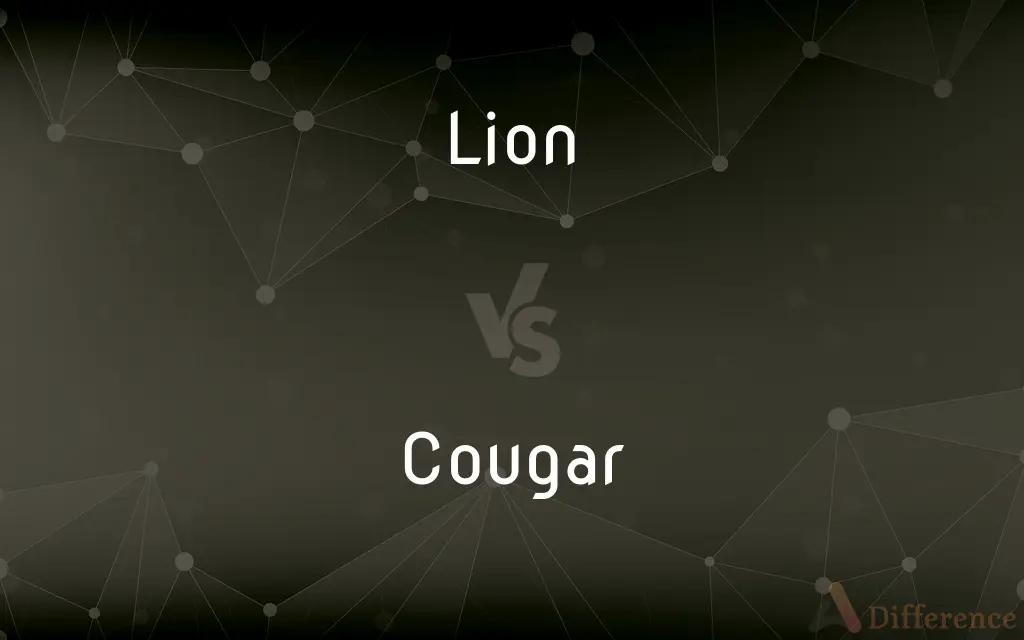Lion vs. Cougar — What's the Difference?
Edited by Tayyaba Rehman — By Fiza Rafique — Updated on November 6, 2023
Lions are social big cats with manes found in Africa and India, while cougars are solitary, maneless, and native to the Americas.

Difference Between Lion and Cougar
Table of Contents
ADVERTISEMENT
Key Differences
Lions, known scientifically as Panthera leo, are large, social felines usually found in prides in Africa and a small population in India. They are recognized for their distinctive manes and are known as the "king of the jungle." Cougars, also known as mountain lions or pumas, bear the scientific name Puma concolor. Unlike lions, cougars do not live in groups and are found in various habitats across the Americas.
Male lions are renowned for their iconic manes, which signify maturity and health. The mane’s size and color can attract females and intimidate rivals. Cougars, both males and females, lack manes and are overall more uniform in appearance. While a lion's roar can be heard up to 8 km away, cougars are known for their screams but cannot roar due to differences in larynx anatomy.
In their habitats, lions typically hunt in coordinated groups and prefer large ungulates. Cougars, as solitary predators, take down prey ranging from insects to large ungulates, often preferring deer. Lions spend much of their time resting and are most active at dusk and dawn, while cougars can also be nocturnal or crepuscular, adapting their habits to avoid human contact.
Conservation status varies between the two species. Lions are classified as vulnerable, with their populations declining due to habitat loss and conflicts with humans. Conversely, cougars have a wider range and are considered of "least concern," though they face habitat fragmentation and persecution in certain areas.
Lions hold a significant place in human culture, symbolizing strength and royalty in various traditions. Cougars also have cultural significance, especially in indigenous cultures of the Americas, where they are often respected as powerful and elusive spirits of the wild.
ADVERTISEMENT
Comparison Chart
Scientific Name
Panthera leo
Puma concolor
Habitat
Africa, small population in India
Americas
Social Structure
Live in prides
Solitary
Physical Characteristics
Males have manes; larger body size
No mane; smaller and more slender
Vocalization
Can roar
Cannot roar; known for high-pitched screams
Compare with Definitions
Lion
A large, social cat with a mane.
The lion's roar echoed across the savannah.
Cougar
A species with a wide range in the Western Hemisphere.
Cougars have been seen as far north as the Canadian Yukon.
Lion
An apex predator in its ecosystem.
The lion plays a crucial role in the balance of the savannah.
Cougar
A creature of stealth and strength.
The cougar used its powerful limbs to leap onto its prey.
Lion
A symbol of strength and nobility.
The royal crest featured a majestic lion.
Cougar
A solitary big cat native to the Americas.
The cougar prowled silently through the underbrush.
Lion
The male of a species known for its pride structure.
The lion watched over his pride from atop the hill.
Cougar
An agile and adaptive predator.
The cougar adapted to various habitats from forests to deserts.
Lion
A carnivorous animal native to Africa and India.
Lions in the Serengeti stalked a herd of wildebeest.
Cougar
Also known as a mountain lion or puma.
A mountain lion, or cougar, was spotted at the edge of town.
Lion
The lion (Panthera leo) is a large felid of the genus Panthera native mainly to Africa. It has a muscular, deep-chested body, short, rounded head, round ears, and a hairy tuft at the end of its tail.
Cougar
The cougar (Puma concolor) is a large cat of the subfamily Felinae. Native to the Americas, its range spans from the Canadian Yukon to the southern Andes in South America and is the most widespread of any large wild terrestrial mammal in the Western Hemisphere.
Lion
A large carnivorous feline mammal (Panthera leo) of Africa and northwest India, having a short tawny coat, a tufted tail, and, in the male, a heavy mane around the neck and shoulders.
Cougar
A large powerful wild cat (Puma concolor syn. Felis concolor) chiefly of mountainous regions of the Americas, having an unmarked tawny body and a long tail. Also called catamount, mountain cat, mountain lion, panther, puma; Also called regionally painter.
Lion
A mountain lion.
Cougar
(Slang) A woman, especially one over 30, who romantically pursues or attracts younger men.
Lion
A very brave person.
Cougar
Puma concolor, a wild feline native to the Americas.
Florida panther
Lion
A person regarded as fierce or savage.
Cougar
An older woman who actively seeks the casual, often sexual, companionship of younger men, by implication a female “sexual predator”.
A cougar approached Warren at the Palomino Club and asked for a dance.
Lion
A noted person; a celebrity
A literary lion.
Cougar
An American feline quadruped (Felis concolor), resembling the African panther in size and habits. Its color is tawny, without spots; hence writers often called it the American lion. Called also puma, panther, mountain lion, and catamount. See Puma.
Lion
Lion See Leo.
Cougar
Large American feline resembling a lion
Lion
A big cat, Panthera leo, native to Africa, India and formerly much of Europe.
Tigers and lions share a common ancestor from a few million years ago.
Lion
(in particular) A male lion, as opposed to a lioness.
Lion
(by extension) Any of various extant and extinct big cats, especially the mountain lion.
Lion
A Chinese foo dog.
Lion
An individual who shows strength and courage, attributes associated with the lion.
Lion
A famous person regarded with interest and curiosity.
Lion
A light brown color that resembles the fur of a lion. en
Lion
(historical) An old Scottish coin, with a lion on the obverse, worth 74 shillings.
Lion
Of the light brown color that resembles the fur of a lion.
Lion
A large carnivorous feline mammal (Panthera leo, formerly Felis leo), found in Southern Asia and in most parts of Africa, distinct varieties occurring in the different countries. The adult male, in most varieties, has a thick mane of long shaggy hair that adds to his apparent size, which is less than that of the largest tigers. The length, however, is sometimes eleven feet to the base of the tail. The color is a tawny yellow or yellowish brown; the mane is darker, and the terminal tuft of the tail is black. In one variety, called the maneless lion, the male has only a slight mane.
Lion
A sign and a constellation; Leo.
Lion
An object of interest and curiosity, especially a person who is so regarded; as, he was quite a lion in London at that time.
Such society was far more enjoyable than that of Edinburgh, for here he was not a lion, but a man.
Lion
Large gregarious predatory feline of Africa and India having a tawny coat with a shaggy mane in the male
Lion
A celebrity who is lionized (much sought after)
Lion
(astrology) a person who is born while the sun is in Leo
Lion
The fifth sign of the zodiac; the sun is in this sign from about July 23 to August 22
Common Curiosities
Where can you find cougars in the wild?
Cougars can be found throughout North and South America in a variety of habitats.
Can lions and cougars interbreed?
No, they are different species with significant genetic differences.
Which is larger, a lion or a cougar?
Lions are generally larger and heavier than cougars.
Are lions endangered?
Lions are classified as vulnerable, facing threats from habitat loss and poaching.
What do lions typically eat?
Lions primarily hunt large ungulates, like zebras and wildebeests.
How do cougars hunt?
Cougars are ambush predators, using stealth and strength to take down their prey.
Share Your Discovery

Previous Comparison
Obligate vs. Obliged
Next Comparison
Sniff vs. SnortAuthor Spotlight
Written by
Fiza RafiqueFiza Rafique is a skilled content writer at AskDifference.com, where she meticulously refines and enhances written pieces. Drawing from her vast editorial expertise, Fiza ensures clarity, accuracy, and precision in every article. Passionate about language, she continually seeks to elevate the quality of content for readers worldwide.
Edited by
Tayyaba RehmanTayyaba Rehman is a distinguished writer, currently serving as a primary contributor to askdifference.com. As a researcher in semantics and etymology, Tayyaba's passion for the complexity of languages and their distinctions has found a perfect home on the platform. Tayyaba delves into the intricacies of language, distinguishing between commonly confused words and phrases, thereby providing clarity for readers worldwide.














































